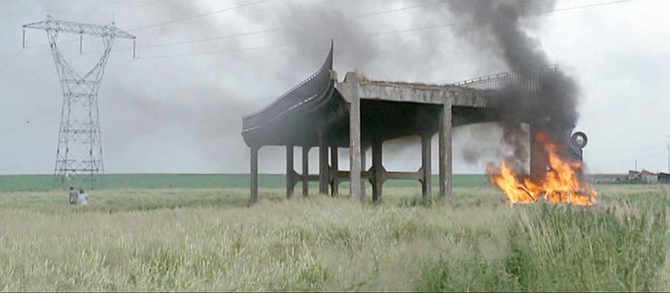Infrastructure Space
Friday, 20 January 2017
Lectures and panel discussion on the occasion of the book launch of Infrastructure Space, edited by Ilka & Andreas Ruby, with a Visual Atlas by Something Fantastic

Still from the film Pierrot le fou, 1965, directed by Jean-Luc Godard
Is infrastructure just the plumbing and wiring of the human environment, or is it the true lifeblood of the spaces we inhabit? Infrastructural systems facilitate the flow of anything from people and goods to resources and information. While engineered to perform specific tasks, such networks also determine the structure of buildings, cities, and metropolitan regions, if not of entire nations and the planet itself. Taking this critical leverage into consideration, three researchers present case studies from Egypt, India, and the Barents Sea that expand the roles of infrastructure not only as a technical, but also as a political, economic, social, and even aesthetic matter.
PROGRAMME
Welcome and Introduction
Dunya Bouchi, Managing Director, ANCB The Aedes Metropolitan Laboratory, Berlin
Ilka Ruby, Ruby Press, Berlin
Edward Schwarz, General Manager, LafargeHolcim Foundation for Sustainable Construction, Zurich
Lectures
Julia King, Architect and urban researcher, LSE Cities, London School of Economics & Political Science (LSE), London: Incremental Infrastructure: Politics, Legality, Development, and Engagement in Delhi
In New Delhi, an estimated one million people were displaced from inner-city slums to resettlement colonies like Savda Ghevra, where they built their homes incrementally on their own. In such areas, water only arrives by tanker and the ratio of communal toilet seats to female inhabitants is 1:250. Together with community members and a local NGO, King built a collectively shared septic tank and up-flow filter, which allowed inhabitants to install private toilets in their own homes.
Charlotte Malterre-Barthes, Architect and urban designer, currently completing her PhD on Food and Territories at ETH Zurich: Biopolitics on the Nile: The Toshka Project
The Toshka Project in Egypt is a huge infrastructural venture, which includes the largest pumping station in the world and a 310-kilometer-long water channel, planned to convert one million hectares of the Western Desert into an agricultural land. Though politics often claims hydrological infrastructure as evidence of national technological achievement, Malterre-Barthes shows how managing the Nile under the auspices of food security works as a control not just of water, but also of population and territory.
Nancy Couling, Architect and recent PhD graduate from the École polytechnique fédérale de Lausanne: The Urbanization of the Ocean
The urbanization of the ocean is a phenomena hard to perceive and still largely outside urban discourse, yet transforming vast areas of sea, mostly through infrastructure. Here, the planetary scales of oceanic systems and urbanization processes merge. In the Barents Sea, Couling shows how primary geometric urbanizing devices colonize ocean space and prepare the ground for increased petroleum activity, in stark contrast to the spatial logic and biological scale of the ocean site itself.
Discussion
moderated by Sarah Nichols, Doctoral Fellow at the Institute for History and Theory of Architecture, ETH Zurich
Infrastructure Space, edited by Ilka & Andreas Ruby, with a Visual Atlas by Something Fantastic. Berlin, Ruby Press, 2017. English, 421 pages, 17,5 x 23,5 mm, hard cover, linen, ISBN: 978-3-944074-18-4, 48 EUR. The book will be on sale during the event.
LafargeHolcim Awards - rewarding smart solutions for cities and the built environment. Competition open till March 21, 2017 at www.lafargeholcim-awards.org
Photos © LafargeHolcim Foundation for Sustainable Construction, Zurich, Switzerland

